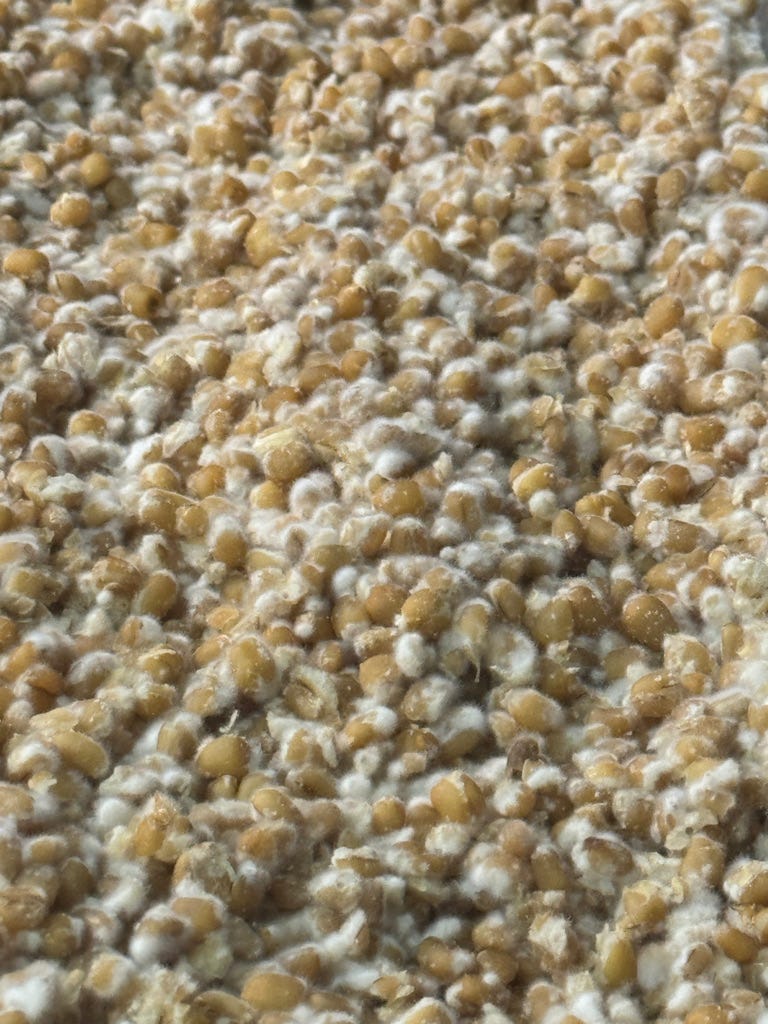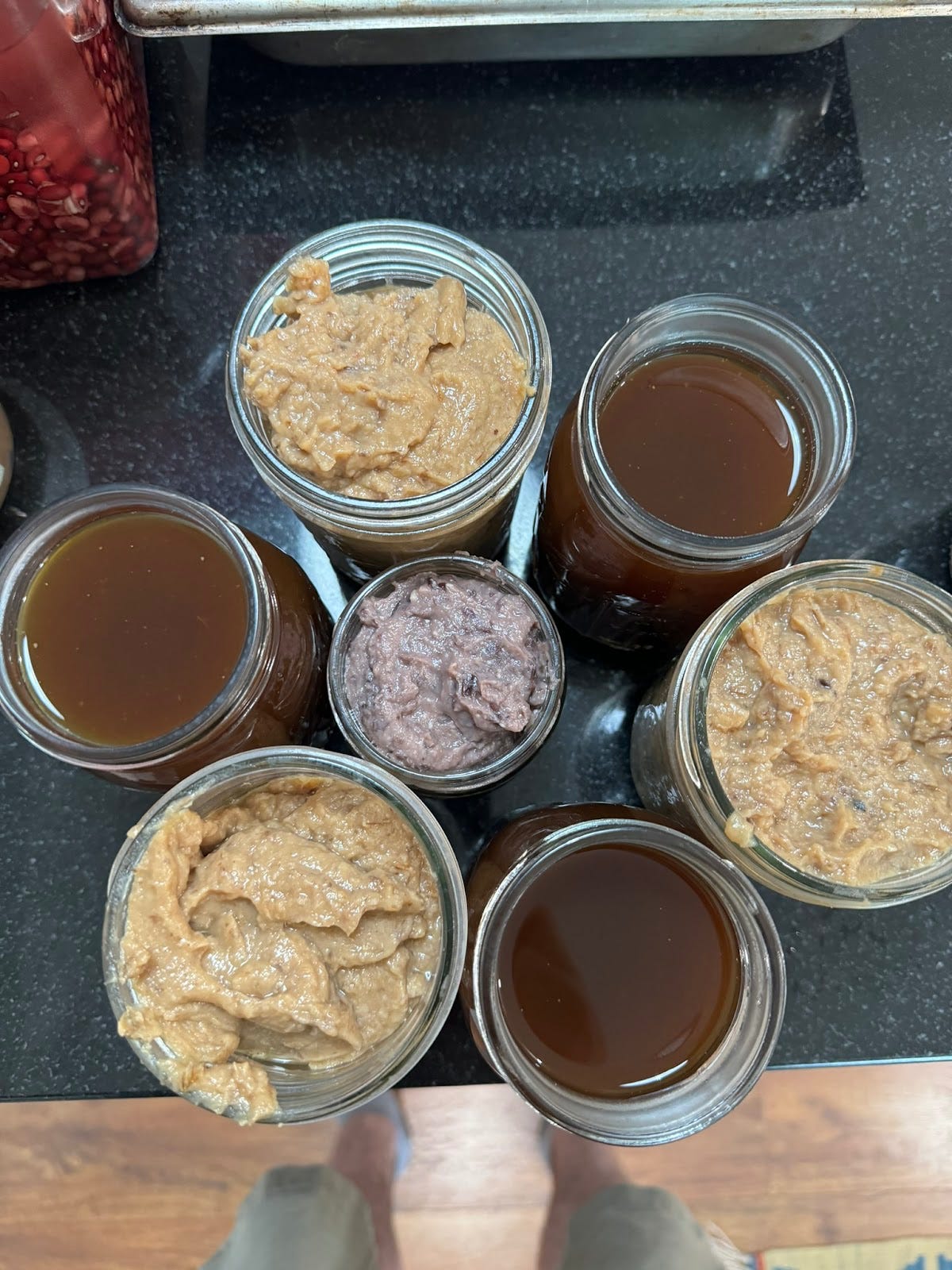Hi all, this guest post is by Nicco Muratore, a Seattle-based chef, teacher, and fermentation expert. He’s here to dig into the importance of place to fermentation projects, and the ways in which the quality and provenance of ingredients can make a huge difference to your results.
He can be found on IG: @niccomuratore and his Linktree includes all of his events, classes, and newsletter.
Here’s Nicco:
Crystie and Keith Kisler own Chimacum Grainery, a 200 acre grain farm/mill/brewery with a malting floor, small bakery, pasta extruding operation, and workshop space. They are organically farming regenerative wheat in the Chimacum Valley in the Northeast Olympic Peninsula in Washington State. I first met Crystie and Keith in 2023 when I tasted their amazing grains in the form of a fantastic sourdough loaf baked on their property in a wood fired deck oven that takes some serious skill to run and operate.
Keith grew up on a grain farm in Eastern WA, where they grew exactly one type of wheat for as long as he can remember. Fast forward to Keith’s own grain operation and they are growing 12 different varieties of grains in partnership with the WSU Bread Lab and they focus on climate resilience and working with the land in the way it deserves, with respect.
Chimacum Grainery has become a community hub of sorts, for bakers, chefs, community members, grain lovers, and customers. A few years ago they started hosting workshops in their outdoor kitchen/pavilion and invited chefs from the Washington food community to come teach their craft to students from all backgrounds. When I saw that Crystie had put a call out to the community for instructors, I immediately reached out, and a wonderful grain relationship (and friendship) was formed. I was really curious about working with their grains and flours, and was inspired to start working on some 100% Washington grown koji projects. I’ve been hosting koji and fermentation workshops at The Grainery every summer since!
Over the years on my koji journey, I have made many fun and delicious things using local products, adding local charred peppers into a miso, preserving and pickling local vegetables with koji, making some chicken of the woods mushroom miso back in Boston, and much more. These products always had a sense of place, or terroir, as the French refer to it, often in a winemaking context: how a product is grown and produced in a region based on the weather that season, the location and environment where it was grown, and who grew/produced it. I find that this can relate to Koji and subsequent ferments in so many ways. Where was your substrate grown (Jasmine rice from Thailand?), what did you mix with it (beans from your grocery store?), and where did you ferment and age it (your house, in the basement?), and voila you’ve got a very nice homemade miso in 6-12 months.
When I was running restaurants and koji and fermentation programs, I was mostly using Jasmine rice as a substrate for koji. It’s relatively easy to work with, steam to the correct doneness, innoculate, and grow beautiful happy koji on. It is also gluten free, which for restaurant flavor building ingredients, is always a plus in the current allergy climate of dining out in the US. Jasmine rice makes phenomenal koji, but it comes from thousands of miles away.
If we want to get deep into the idea of terroir with our koji projects and ferments, we need to look closer to home. This is where my initial excitement with working with Chimacum grains came from—not to mention they are fabulously delicious. The idea was simple: Make 100% Washington-grown misos and amino sauces.
It took a few tries to really nail the wheatberry koji from Chimacum. Their grain is fully intact, so it has a rather tough hull. There are a few ways to get around this, with the most successful technique being breaking up the grains a bit before inoculating and exposing the starch inside to provide the koji the food it needs to grow successfully. Another technique that has yielded great results is to sprout the wheatberries and let them break their hull naturally before steaming and inoculating the grains.
Now that we have local koji grown on beautiful Washington grains, what to make with it? I always make some shio koji when I grow large batches of koji, to use for short term projects: marinating proteins before cooking, adding to sauces and dressings, and as a tasty umami seasoning to keep in the fridge. But my excitement was really geared towards the longer term ferments, misos, amino sauces, shoyu, etc. This was going to take time, but it was something worth waiting for.
The first summer I worked with the Chimacum koji, I decided we should make some miso to age and find some excellent quality beans from WA state. I looked no further than the wonderful Alvarez Organic Farm in Yakima, WA. The Alvarez family is wonderful and grows an abundance of beautiful vegetables, fruits, and legumes in the dry east cascade plateau of the Yakima Valley. I worked with them for years when I was buying produce for restaurants in Seattle. Their fresh sheets were always something to look forward to in the summer, when they have 15+ kinds of peppers, all sorts of tomatoes, squash, tons of bean varieties, and so much more.
In the fall, they begin to sell their dried beans that they let dry on the vine before harvesting before the first rains of the season. They grow some of the best dried beans I have ever had (Rancho Gordo, watch out). For the first experiments with an all Washington ingredient miso, we made Alvarez pinto bean and Chimacum wheatberry miso, followed by Alvarez black bean and Chimacum wheatberry miso. Both turned out fabulously—delicious pastes with tons of umami, massive depth, and unmatched flavor. I let them both ferment for 12 months, and shared the end result with farmers from both Chimacum and Alvarez to thank them for the work they put into growing the products that resulted in these misos.
The next project was something I had been thinking about for a while: how to incorporate our bounty of wild mushrooms in the PNW to a koji based ferment. The idea for a mushroom shoyu came to be. This isn’t a new idea by any means, but what if we used koji that was grown on WA grains and beans and mushrooms that I foraged and dried from the Cascade mountains? The ideal mushroom candidates for this project were what I had in my pantry from the previous season: dried morels and porcini from the East Cascades.
Porcini have tons of umami and bring deep earthy and woody flavors to the table. Dried morels have a fabulous flavor and some dark chocolate-coffee notes when powdered. Both of these together seemed like the logical choice, and the first batch was off to the races. I followed the standard ratios for shoyu with equal parts bean and wheat koji to water, and 12.5% salt on the whole—but with the addition of the dried morels and porcini at 2%, which was a decent amount considering how light dried mushrooms are.
I transferred everything into a 4-quart container, and let the magic happen. I stirred every few days for the first couple of weeks, and then put some plastic wrap over the surface of the shoyu with a light weight to prevent too much yeast and mold growth on the surface as the shoyu fermented. Then it was covered lightly and I let it ferment in my basement for 12 months. 12 months to the day (I couldn’t wait any longer), I pressed the shoyu and let it strain overnight through cheesecloth with a light weight on it). I was greeted with a fabulous smelling and tasting ferment, my first all Washington grown and foraged shoyu.
The depth of flavor is insane, with so many layers of flavor to relish in, depth from the mushrooms, amazing flavor from the black beans from Alvarez and the wheat from Chimacum, all rounded out with the fantastic umami from the 12 month fermentation, an all around success. I’ve been using it in all sorts of dishes with great success, and sharing the story of it as I have brought it as a flavor builder to many dinners, classes, and events.
So where to go next? I’m working on some single mushroom shoyus with the same grain/bean process as described above, and I’m looking forward to the fall mushroom season here in the PNW to continue this process with some of my favorite late fall aromatic mushrooms- the matsutake, yellowfoot chanterelles, and black trumpets for tasty flavor additions for future miso and shoyu making. This Koji Terroir project has been a fun rabbit hole to go down, and I can’t wait to taste what’s next!
Have you made something similar? Let us know! We would love to hear about it!
Let’s Connect!




